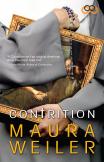The Sisters’ Story
Preparing to enter the Jesuit novitiate in 1868, Gerard Manley Hopkins famously incinerated the poems he had written up to that point. Hopkins later quipped that “brilliancy does not suit us” (i.e., Jesuits), a lapidary distillation of the tension he and others have seen between deploying one’s talents (particularly artistic talents) and heeding a call to communion with God in religious life.
A similar tension surfaces repeatedly in Maura Weiler’s debut novel, Contrition. The book’s narrator and protagonist is Dorie McKenna, a young and restless tabloid journalist from Los Angeles. Childbirth claimed both Dorie’s mother and the full use of her right hand, a physical deformity that looms large at various points in the novel’s plot. Dorie was likewise separated from her father and twin sister mere months after birth.
The death of Dorie’s last remaining adoptive parent sets off the novel’s plot. After learning that she is heir to an immensely valuable painting by her biological father (a famous abstract artist), Dorie also finds that her twin became a cloistered nun in nearby Big Sur, Calif., after their father died.
Hoping to connect with her sister, Dorie proves herself a distinguished liar. Visiting the cloister, the “collapsed Catholic” fakes interest in a vocation to learn about the monastery. Once inside, Dorie observes a stunning painting by one of the cloistered nuns, in which Christ’s right hand appears much like her own. Somewhat unsurprisingly, the artist is her sister, who has conveniently taken a vow of total silence.
Mercifully, Contrition does not exploit the possible suspense of Dorie’s meeting with her sister. After two initial interactions fail to yield a reunion, Dorie again pretends vocational interest to gain a two-week stay in the convent. Even their eventual reunion is somewhat anticlimactic. Catherine has known all along that the aspirant is her sister.
Gradually, Dorie’s interactions with the nuns brings up a fairly obvious question: is she really lying about her vocation? Her relatively few visits to Big Sur diminish not only her obsession with career, but also dispatch her cravings for booze, cigarettes and men. She briskly returns to the faith of her childhood. Alas, this religious “relapse” feels as predicable as her eventual confession that maybe she wasn’t lying about the vocation after all.
During Dorie’s two-week visit, the nuns announce that they are in financial straits. When the journalist’s private notes from the visit and her photos of Catherine’s masterpieces are published against her will and without her permission, the twins find themselves instantly famous and singularly unhappy. The convent, however, has found a potential path to solvency: selling off Catherine’s paintings. The only question is what will happen when the silent nun’s method of creative prayer (she swears that God paints, not she) is co-opted for financial benefit?
It is perhaps best to view these siblings as perpendicular characters: heading in quite different directions, the pair nevertheless has an intensive period of convergence, intersection and divergence. Each twin discovers more about herself, and this draws one closer toward the monastery while repelling the other. Perhaps because Catherine is silent for so much of the novel, the reader knows rather little about her motivation and personality, resulting in an underdeveloped and, frankly, odd character.
As the book’s subtitle suggests, rivalry between these siblings looms large throughout their budding relationship. Jealous of her sister’s artistic prowess, Dorie is able to tap her own creative forces only as her relationship with God develops throughout the novel. And as Catherine’s own output becomes less about prayer and more about profit, her creativity ebbs.
This is indeed an interesting theme in the novel. At times, however, it almost seems that Weiler is concerned that readers will overlook it. Not only is it announced in the subtitle, it is also trumpeted rather heavy-handedly at certain points. This is perhaps a second theme, though likely unintended. Readers need not worry about observing nuance in this novel. The distressed mother superior reflexively clutches her stomach when finances are discussed. If one misses this detail, fear not. She later begins swigging Mylanta from the bottle at the mere mention of money. The resulting characters, perhaps excepting Dorie, often resemble parodies more than personalities.
Similarly, the novel trades on a tired stereotype of religious as a spiritual elite floating above the run of mere mortals. It is only a slight exaggeration to say God’s presence is physically confined to the monastery at Big Sur, as though grace worked only in a certain ZIP code. Those straying from the holy mountain watch their connection to the deity wane, while Dorie’s eventual entrance yields an immediate cure of her hand the very moment she accepts the veil. (“This proves it…. You’re exactly where you belong, Dorie,” gushes her erstwhile lover and almost-fiancé). With all respect to miracles and sacred space, it is here that the novel swerves into mawkish hagiography of religious life.
Nevertheless, Weiler’s book is obviously the fruit of considerable research into the various forms of women’s religious life in the Catholic Church. It is here that the book excels, as well as in those places where Weiler, herself a practitioner of the visual arts, probes the historically well-attested nexus between prayer, spirituality and artistic creativity on the other. It is here that she writes powerfully, knowingly even, about how artistic creativity serves as a privileged pathway to the divine.
This article also appeared in print, under the headline “The Sisters’ Story,” in the August 31-September 7, 2015, issue.








